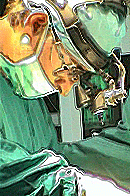|
|
|
|
|
|
|
|
The length and quality of postoperative survival are the most important indicators by which one can evaluate the results of any treatment for supratentorial brain tumors, The inherent risk of surgery as a treatment modality requires that some analysis also be made of perioperative morbidity and mortality. The 30-day operative mortality for glioma surgery remained in the range of 20 to 40 percent until the advent of corticosteroids and modern neuroanesthesia in the early 1960s, Since then there has been a steady decline in surgical risk, and the authors of several published series have achieved mortality rates of less than 3 percent. Recent attention to the details of surgical technique have also probably contributed to this steady improvement. It is the general opinion of experienced operators that limited biopsy at open surgery poses a greater risk to the patient than either radical excision or a stereotactic procedure, and this is borne out by a retrospective analysis of the available survival data. The selection bias in these data is quite strong, because there is a tendency for older and sicker patients to receive more limited surgical procedures. Nevertheless, the analysis is based on 603 patients drawn from the literature who did not receive postoperative radiation for glioblastoma, and it is quite unlikely that any better data will ever be accrued on the effects of surgery uncontaminated by the influence of other concomitant therapies. Because the extent of surgical resection for cancers elsewhere in the body can also be correlated with the length of postoperative survival, the general principle that radical excision is preferable to either partial removal or simple biopsy is adequately supported. The operating microscope and the carbon dioxide laser facilitate the performance of a more radical tumor removal in greater numbers of patients and with correspondingly less operative morbidity and mortality. Somewhat surprisingly, relatively little attention has been paid to postoperative morbidity, because survival was the prime issue of importance in the early series. Davis and his associates did provide several anecdotal reports of patients retaining the ability to fulfil their economic and social obligations but made no statistical analysis. In 44 patients surviving more than 3 months after surgery for glioblastoma, Hitchcock and Sato found that 76 percent had a "useful" survival of at least 6 months but that only 28 percent were able to return to work. Of course, the failure of patients to return to work is subject to many factors other than the postoperative neurological condition; among these are familial, social, psychological, and economic influences. Up to 40 percent of postoperative survivors are neurologically normal or suffer from minimal deficits such as facial weakness and quadrantanopsia; another 26 percent suffer from more severe deficits, including hemiparesis, but remain ambulatory and able to care for themselves, Patients undergoing extensive resections have the greatest likelihood of improving their preoperative condition and achieving some degree of independent existence. Resection of neuroectodermal tumors is more likely to alleviate existing symptoms than to produce additional ones. Beneficial changes in cerebral metabolism and blood flow may underlie some of these functional improvements.
Without radiation, the median postoperative survival for patients with glioblastoma is only 4 months, even if all cases with limited resections or simple biopsies are excluded. The addition of postoperative irradiation increases this figure to 9.25 months and improves the 2-year survival rate from 3 to 11 percent. Although the use of postoperative irradiation increases the proportion of patients surviving at all intermediate points in the first 18 months following surgery, the natural course of the disease is such that all survival curves, irrespective of the mode of treatment, appear to converge at 18 to 24 months after diagnosis. Nevertheless, the value of irradiation is unequivocal, because virtually all study groups that have reported a zero percent 2-year survival rate also failed to irradiate their patients. Unfortunately, the amount of external irradiation that can be safely delivered is limited by the sensitivity of the brain and its blood vessels to the detrimental effects of ionizing radiation.
|
|
|
Introduction |Imaging | Astrocytomas | Glioblastoma Multiforme | Oligodendrogliomas | Ependymomas | Pilocytic Astrocytomas | Gangliogliomas | Mixed Gliomas | Other Astrocytomas | Surgical treatment | Stereotactic Biopsy | Gliadel Wafers |Results and complications | When to Reoperate? | Colloid cyst
Copyright [2022] CNS Clinic - Jordan]. All rights reserved

